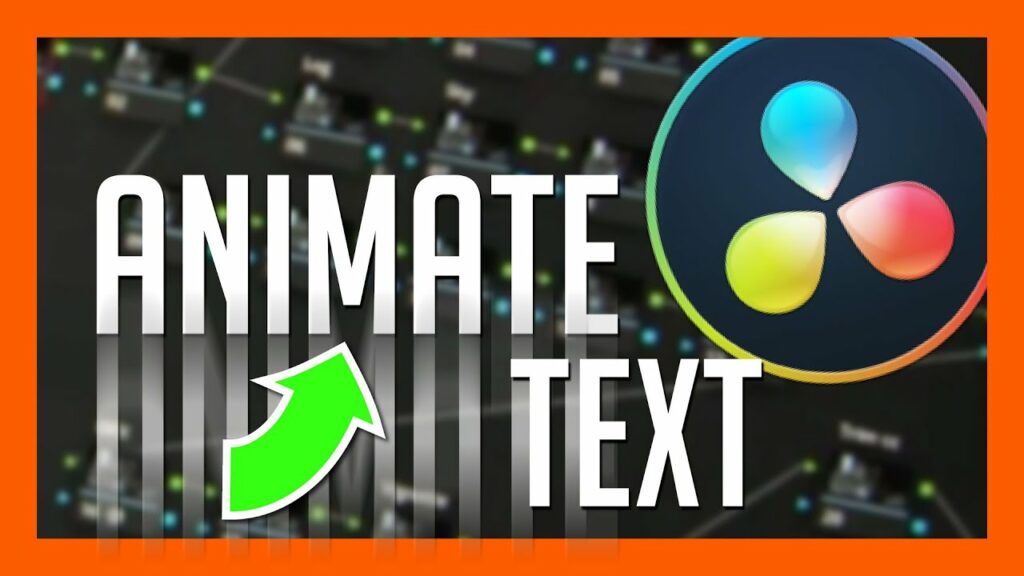Mastering Motion: An Extensive Guide to Animating Text in DaVinci Resolve

Introduction:
Text animation is a powerful technique that adds dynamism, visual interest, and engagement to your videos. In DaVinci Resolve, a versatile and feature-rich editing and compositing software, animating text is intuitive and flexible, allowing you to bring your words to life with captivating motion. In this extensive guide, we’ll delve deep into the art of animating text in DaVinci Resolve, equipping you with the knowledge and techniques to elevate your videos with dynamic and compelling typography.
Understanding Text Animation in DaVinci Resolve:
Text animation involves creating movement, transitions, and effects to animate text elements within your video. In DaVinci Resolve, text animation can be achieved using keyframes, easing curves, and a variety of animation controls within the Fusion page. Whether you’re animating titles, lower thirds, captions, or subtitles, DaVinci Resolve offers a comprehensive set of tools to customize and fine-tune text animations to suit your creative vision.
Using DaVinci Resolve for Text Animation:
Let’s explore the step-by-step process of animating text in DaVinci Resolve:
- Open the Fusion Page:
- Launch DaVinci Resolve and open your project. Navigate to the Fusion page by clicking on the Fusion tab at the bottom of the interface. Fusion is DaVinci Resolve’s node-based compositing environment, where you’ll create and animate text elements.
- Add a Text Node:
- Start by adding a Text node to the Fusion composition. Right-click in the node graph and select “Add Tool” > “Text” to create a new Text node. This will serve as the foundation for your animated text.
- Customize Text Properties:
- With the Text node selected, open the Inspector panel to access the text properties. Here, you can customize various aspects of the text, including font, size, alignment, color, and spacing. Type the text you want to animate into the Text field and adjust the properties to achieve the desired look.
- Position and Transform:
- Use the Transform controls in the Inspector panel to position, scale, and rotate the text within the composition. You can also adjust the anchor point to control the pivot point for transformations.
- Add Keyframes:
- To animate the text, enable keyframing for the desired text properties such as position, scale, rotation, opacity, or any other attribute you wish to animate. Move the playhead to the desired frame, adjust the text properties, and set keyframes to mark the beginning and end of the animation.
- Customize Animation Curves:
- Fine-tune the animation curves to control the timing and easing of the text animation. Use the animation curve editor to adjust the acceleration and deceleration of the animation, creating smooth transitions and dynamic movement.
- Add Additional Effects (Optional):
- Enhance your text animation with additional effects and styles to add visual interest and polish. DaVinci Resolve offers a wide range of built-in effects, such as drop shadows, glows, outlines, gradients, and textures, which you can apply to your text elements to create unique and visually appealing animations.
- Preview and Fine-Tune:
- Preview the text animation in the viewer window to assess its appearance and behavior. Fine-tune the animation curves, effects, and timing as needed to achieve the desired look and feel for your animated text.
- Composite Text Animation:
- Once you’re satisfied with the text animation, integrate it into your timeline on the Edit page. Simply drag and drop the Fusion composition containing the animated text onto the timeline to overlay it onto your footage.
- Export Your Project:
- Finally, render your project to export the final video with the animated text included. Navigate to the Deliver page, configure the export settings, and click “Add to Render Queue” to queue the project for rendering. Then, click “Start Render” to export the video with your animated text.
Best Practices for Text Animation:
To create impactful and visually appealing text animations in DaVinci Resolve, consider the following best practices:
- Plan Your Animation:
- Before animating text, plan your animation and identify the key elements and transitions you want to achieve. Consider the purpose, audience, and context of your video to inform your animation decisions.
- Keep It Simple and Readable:
- Keep your text animations simple, clear, and readable. Avoid excessive movement or distracting effects that may detract from the message. Aim for clarity and legibility, especially if the text contains important information.
- Use Animation Wisely:
- Use animation to enhance the impact of your text, but avoid overdoing it. Choose animation styles and effects that complement the content and reinforce the message of your video. Consider the tone and mood of your video when selecting animation techniques.
- Pay Attention to Timing:
- Pay attention to the timing and duration of your text animations within the video. Ensure that they appear and disappear at appropriate moments, allowing sufficient time for viewers to read and digest the information.
- Test on Different Devices:
- Test your text animations on different devices and screen sizes to ensure compatibility and readability across various platforms. Consider how they will appear on small screens, mobile devices, and large displays to optimize the viewing experience.
Conclusion:
Animating text in DaVinci Resolve is a creative and rewarding process that allows you to enhance your videos with dynamic and compelling typography. By leveraging the animation tools and controls available in DaVinci Resolve’s Fusion page, you can create text animations that captivate your audience and reinforce your message. Whether you’re producing tutorials, promotional videos, title sequences, or any other type of content, mastering the art of animating text in DaVinci Resolve empowers you to elevate the production value of your projects and deliver engaging visual storytelling. Experiment with different techniques, explore creative possibilities, and let your imagination soar as you bring your words to life with captivating motion.







